By Hali Serrian
There are times in every martial artist’s life when they can’t be at the dojo. Maybe you’re  on vacation, interviewing for a job in another state, or just away for whatever reason. You can still practice karate, even in a hotel room! And it’s good to keep up your practice so when you return you’ll be able to jump back in right where you left off. In this post, I’ll be focusing on some exercises you can do in a hotel room, or anywhere there’s not as much space as we have in the dojo.
on vacation, interviewing for a job in another state, or just away for whatever reason. You can still practice karate, even in a hotel room! And it’s good to keep up your practice so when you return you’ll be able to jump back in right where you left off. In this post, I’ll be focusing on some exercises you can do in a hotel room, or anywhere there’s not as much space as we have in the dojo.
Kata
You can run forms in a small space, it just takes creativity and a bit of flexibility. Try to find the most open space you can and get started. Once you reach a wall (if you’re doing the I-Forms this will probably happen somewhere going up or down the “I”), just scoot back a couple steps and keep going. It can be a bit weird at first, but you’re still getting practice for the form in.
Kicks
Kicks are fairly easy to practice on the go because they don’t take up much space. The same applies for punches and blocks. If you’re looking for a different way to work on your kicks, try the exercise where you hold one hand on a wall, chamber for your kick, and extend out and in without putting your foot down 10 times. Then on the last extension, hold your leg out for a 10-count. This can be quite a workout, and it helps you with your kicking form without having to worry about balance.
kicks, try the exercise where you hold one hand on a wall, chamber for your kick, and extend out and in without putting your foot down 10 times. Then on the last extension, hold your leg out for a 10-count. This can be quite a workout, and it helps you with your kicking form without having to worry about balance.
Balance
You can work on balance while you’re away, like the drills that you do while practicing at home. Stand on one leg (Ippon Ashi Dachi) while you watch T.V., brush your teeth, or talk on the phone. For a tougher version, try moving your leg up and down, side to side, or in a circle, all while keeping the 90 degree bend in your knee. Then try straightening the leg without setting it down. Lean forward and backward on one leg, and then shift your weight side to side. If it gets too tough, focus your gaze on one spot. If it gets to easy, let your gaze wander or close your eyes completely.
Calisthenics
If you don’t feel like working karate specifically, you can simply do some basic exercises, most of which don’t take up a lot of room. Pushups, bodyweight squats, lunges, crunches, dead cockroaches, jumping jacks, shadow boxing; the possibilities are endless. Anything that gets your heart pumping and your blood moving can help you in your martial arts training.
There is plenty to do for your training even when you’re not in the dojo. Keeping up your practice is what helps you continue along a steady path even if you can’t always have steady attendance.

 conditioning is the practice of taking hits to the body or hitting something fairly tough in order to strengthen one’s ability to “take a hit”. It is supposed to make the body stronger, but often it’s mostly the fighter getting used to being hit. When fighting, blows don’t hurt as much because they’re used to it through body conditioning.
conditioning is the practice of taking hits to the body or hitting something fairly tough in order to strengthen one’s ability to “take a hit”. It is supposed to make the body stronger, but often it’s mostly the fighter getting used to being hit. When fighting, blows don’t hurt as much because they’re used to it through body conditioning. In Okinawan tradition, makiwara, or punching boards, are used to toughen up striking surfaces. These are exactly what they sound like: boards that you hit in order to toughen up. Trees and poles are acceptable makiwara substitutes.
In Okinawan tradition, makiwara, or punching boards, are used to toughen up striking surfaces. These are exactly what they sound like: boards that you hit in order to toughen up. Trees and poles are acceptable makiwara substitutes.